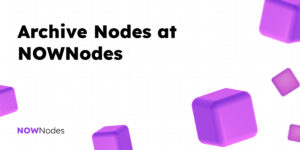If you’ve ever built on blockchain, you know how important it is to have reliable access to on-chain data. Verge (XVG) is no exception. Developers need quick ways to check balances, look up transactions, or broadcast new ones — and that’s where Blockbook comes in.
What is Blockbook?
Blockbook is an open-source blockchain indexer that sits on top of a full node. In simple terms, it’s like a super-powered search engine for the blockchain. Instead of scanning the entire Verge ledger manually, Blockbook provides fast API endpoints that let you:
- check the balance of any address,
- fetch transaction details,
- explore blocks by height or hash,
- and even push raw transactions into the network.
NOWNodes hosts Blockbook for Verge and other chains, so you don’t need to set up or maintain a heavy server yourself. That means less time worrying about infrastructure and more time building your app.
Getting Started with NOWNodes
To use Verge Blockbook, you’ll first need access to NOWNodes. Here’s how:
- Sign up on NOWNodes
Go to nownodes.io and choose a plan which suits you. - Generate your API key
Once you’re registered, you’ll get an API key — a unique string that authorizes your requests. Think of it as your personal pass to the NOWNodes infrastructure. - Keep it safe
Don’t share your key publicly. If someone else uses it, their requests will count toward your quota. Store it in environment variables, not inside your GitHub repo.
That’s it. You’re ready to start making API calls.
Example: Checking a Verge Address Information
Let’s look at just one method to see how it works in practice: fetching the balance, balance, total received and sent, unconfirmed transactions and more of a Verge address.
With Blockbook, you can do this in a single HTTP request. Here’s what it looks like:
GET /api/v2/address/{address} HTTP/1.1
Host: xvg-blockbook.nownodes.io
api-key: YOUR_API_KEY
Accept: */*
What you’ll get back is a JSON response with:
- the total balance,
- how much has been received,
- how much was sent,
- and a list of recent transactions (if you request details).
Here’s an example of the response:
{
"page": 1,
"totalPages": 1,
"itemsOnPage": 100,
"address": "DJUJgi3rB2FXeXC5wpeBSXa4fwr25NQWzo",
"balance": "570644338255149800",
"totalReceived": "1049780097899349800",
"totalSent": "479135759644200000",
"unconfirmedBalance": "0",
"unconfirmedTxs": 0,
"txs": 54,
"txids": [
"093b63611ef26437885eebff1a55c68a8941207bc6c8e3324599c9680c52ff86",
"935692531b63f6dda10b90fd8eeaab6e5a68c3a0dfdf8fe09d5b2cb113a7f5aa",
"06b5445b236ebbfeea2016ece7d250454596c5f9473628d0b5f2d76fa07f0f56",
"048617ab99816398361cec9cb6b02f7cc5a28dccbee9c4104b68535ac00c6bb1",
"ff38151e3eefc4e04890b77552429b1a801ebbe3674254baba8f505be0955407",
"b0ca0495713de45d489c2fcd6727e16fb455a4bad6430011c52b53fc904929e5"
]
}
This is incredibly useful for wallets, explorers, or any service that needs to show live account data to users. Instead of waiting for confirmations or parsing the chain yourself, Blockbook gives you instant answers.
Why It Matters
Imagine you’re building a Verge payment gateway. Every time a customer sends XVG, you need to check if their transaction arrived. With Blockbook, you don’t need to run a Verge node or worry about uptime. Just call the API, and the information is there.
This kind of lightweight integration is the reason so many developers rely on NOWNodes: it speeds up development, keeps costs low, and removes the hassle of node management.
Final Thoughts
Blockbook is more than just an API — it’s the bridge between the Verge blockchain and your application. With NOWNodes, you don’t have to run a full node to get powerful blockchain insights. With nothing more than an API key and a few lines of code, you can start exploring Verge data today.



